Fire safety is a critical aspect of both residential and commercial environments, emphasizing the importance of having suitable firefighting equipment readily available. Wet chemical fire extinguishers are one such crucial tool, specifically designed to combat particular fire scenarios involving cooking oils and fats, primarily occurring in commercial kitchens. These extinguishers play a pivotal role in mitigating damage and preventing the escalation of fires by employing a unique mechanism that involves the use of alkali salts to create a cooling and sealing foam.
This blog will delve deep into the specifics of wet chemical fire extinguishers, exploring their features, characteristics, and the types of fires they are designed to combat. It will provide insights into proper usage, installation locations, maintenance, and safety guidelines, emphasizing the benefits and limitations inherent to these extinguishers.
Additionally, we will discuss the vital aspects of regulations, compliance, and the importance of training and education in ensuring effective and safe utilization of these extinguishers in various settings, thereby enhancing the overarching understanding of fire safety protocols and procedures.
What Are Wet Chemical Fire Extinguishers?
Wet Chemical Fire Extinguishers are a type of fire extinguisher specifically designed to tackle fires involving cooking oils and fats, referred to as Class F fires. These extinguishers are indispensable in commercial kitchens and other places where large volumes of cooking oils are used.
They are identified by a yellow label on the extinguisher body and are a critical component of fire safety protocols within the catering and food preparation industries.
Composition and Key Components
The primary component of Wet Chemical Fire Extinguishers is a solution of alkali salts mixed in water, pressurized with nitrogen. The alkali salts typically include substances like potassium acetate, potassium carbonate, or potassium citrate.
These agents are crucial as they react with the burning oil or fat to form a soapy foam, creating a seal and preventing re-ignition. The container is usually made of stainless steel, featuring a long hose with a lance attachment to allow the user to apply the wet chemical from a safe distance.
How They Work to Extinguish Fires
Wet Chemical Fire Extinguishers operate uniquely compared to other types of fire extinguishers. When activated, they release a fine mist of wet chemical solution. This mist works in several ways to extinguish fires:
- Cooling: The mist has a cooling effect on the fire, reducing the overall temperature and helping to stop the fire from spreading.
- Blanketing: The mist acts to smother the fire, cutting off the oxygen supply and, thus, quenching the flames.
- Saponification: The potassium salts within the wet chemical agent react with the hot oils and fats to form a layer of soapy foam on the surface of the burning material. This foam acts as a barrier, sealing the surface and preventing vapors from being released, thus inhibiting re-ignition.
This multi-faceted approach, targeting various elements of the fire triangle—heat, fuel, and oxygen—makes Wet Chemical Fire Extinguishers highly effective against Class F fires. It’s the combination of cooling, smothering, and creating a chemical barrier that distinguishes wet chemical extinguishers from other types in handling fires involving cooking oils and fats.

Types of Fires Wet Chemical Extinguishers Are Designed for
Wet chemical fire extinguishers are primarily designed to tackle fires that are a result of cooking oils and fats. These fires are particularly challenging to manage due to the high temperatures at which these oils burn. Let’s dive into the specific types of fires they are designed to combat:
1. Class K Fires (Kitchen Fires)
Wet Chemical Fire Extinguishers are primarily tailored for Class K fires, which are synonymous with kitchen fires. Class K fires involve cooking media such as oils and fats, typically found in commercial kitchen environments.
The high temperatures involved in these types of fires make them particularly challenging to control and extinguish, necessitating specialized solutions like wet chemical extinguishers.
2. Fires Involving Cooking Oils and Fats
These extinguishers are the optimal solution for fires arising from vegetable and animal-based oils and fats. The nature of cooking oil fires, characterized by high auto-ignition temperatures, makes them highly volatile and resistant to traditional extinguishing methods.
Wet chemical extinguishers address this by rapidly knocking out the flames, cooling the burning oil, and inducing a chemical reaction that forms a soap-like solution, which seals the surface and prevents re-ignition.
3. Applicability in Commercial Kitchens and Restaurants
Given the prevalence of large volumes of cooking oils and high-temperature cooking methods in commercial kitchens and restaurants, wet chemical extinguishers are indispensable in these settings. Establishments like fast-food chains, burger bars, fish and chip shops, and other eateries with deep-frying processes extensively employ these extinguishers to safeguard against inherent fire risks.
Moreover, their utility extends to any facility with commercial cooking equipment, emphasizing their pivotal role in ensuring fire safety within the food service industry. Their strategic placement and accessibility in such environments are crucial to enable prompt response in the event of a fire, minimizing potential damage and harm.
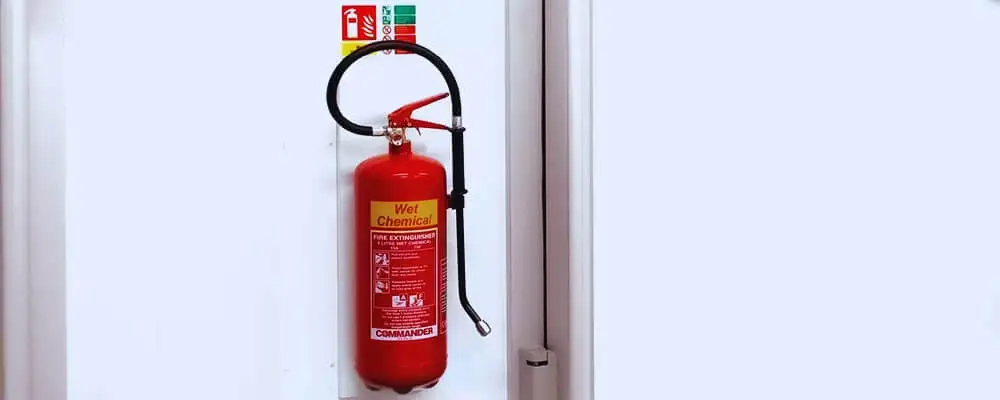
Features and Characteristics Of Wet Chemical Extinguishers
Wet chemical fire extinguishers are distinct in their design and functionalities, specifically catering to fires involving cooking oils and fats. Here are the features and characteristics of wet chemical extinguishers:
1. Design and Construction
Wet Chemical Fire Extinguishers are typically characterized by a sturdy cylindrical body, predominantly red, with a yellow band or label indicating “Wet Chemical.” This design adheres to standardized color coding, facilitating easy identification during emergencies. The construction is meticulously designed to withstand internal pressure, ensuring durability and reliability when needed the most.
2. Size and Capacity Options
These extinguishers are available in various sizes and capacities, ranging from 2 liters to 6 liters and above, allowing users to choose according to their specific needs and the degree of fire risk involved. The different sizes enable establishments to select the most appropriate extinguisher that aligns with the spatial constraints and fire load present within their premises.
3. Pressure and Discharge Mechanisms
The pressure mechanism in a wet chemical extinguisher is calibrated to release the extinguishing agent in a controlled manner. It usually employs a pressurized solution of alkali salts in water. The discharge mechanism is designed to deploy the wet chemical in a fine spray form, allowing a gentle yet thorough application. This ensures the rapid cooling of burning oils and induces a saponification process, sealing the surface and preventing re-ignition.
4. Handle and Nozzle Design for Ease of Use
The handle and nozzle are integral components designed with user comfort and safety in mind. The handle typically has levers that users can squeeze together to release the extinguishing agent. The nozzle or lance is elongated, allowing users to maintain a safe distance from the fire while applying the agent in slow circular movements.
This ergonomic design enables a precise and controlled application, crucial in handling volatile and high-temperature fires involving cooking oils and fats. The intuitive design of the handle and nozzle thus contributes to the overall effectiveness and ease of use of the wet chemical fire extinguisher in emergency situations.
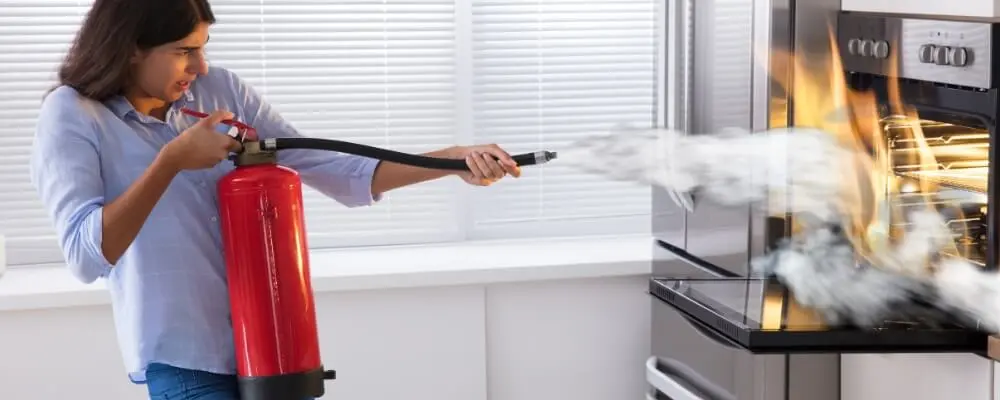
How to Use a Wet Chemical Fire Extinguisher
Using a Wet Chemical Fire Extinguisher properly is crucial to safely putting out a fire. Here are step-by-step instructions on how to use one:
1. Step-by-Step Instructions for Proper Usage
- Identify the Fire: Before using the extinguisher, ensure that the fire involves cooking oils or fats (Class K/F).
- Secure the Area: Evacuate any non-essential personnel from the vicinity.
- Turn Off Power: If safe to do so, turn off the source of heat or any electrical appliances involved in the fire.
- Stand at a Safe Distance: Position yourself at least 1 meter away from the fire.
- Hold the Lance: Hold the lance or applicator at arm’s length, well above the fire.
- Aim the Nozzle: Aim the applicator tip towards the base of the fire.
- Squeeze the Levers: Squeeze the levers on the operating head together to discharge the wet chemical agent.
- Apply in Circular Motions: Using slow, circular movements, allow the wet chemical to fall gently onto the surface of the fire, covering the complete area. Continue even if the fire appears to be out quickly.
- Empty the Extinguisher: It is important to discharge the entire contents of the extinguisher to ensure the fire does not reignite.
2. Importance of Reading Instructions and Labels
Reading the instructions and labels on the extinguisher is crucial for safe and effective use. The labels provide vital information about the extinguisher’s intended use, operational instructions, and safety precautions.
Understanding this information is essential to ensure that the extinguisher is used correctly and safely, minimizing the risk of harm to the operator and others in the vicinity.
3. Safety Precautions When Operating
- Never Use on Electrical Equipment: Given the conductive nature of the wet chemical agent, it should not be used on fires involving live electrical equipment.
- Wear Appropriate Protective Equipment: If available, wear protective gear like gloves and a face shield to protect against splashes and fumes.
- Avoid Inhaling Fumes: Wet chemical extinguishers can produce toxic fumes. Avoid breathing them in, and ensure the area is well-ventilated after use.
- Ensure Safe Escape Route: Always ensure there is a clear and safe escape route behind you in case the fire escalates.
- Alert Emergency Services: Regardless of the apparent success in extinguishing the fire, always alert the local fire department to ensure the fire is completely out and the area is deemed safe.
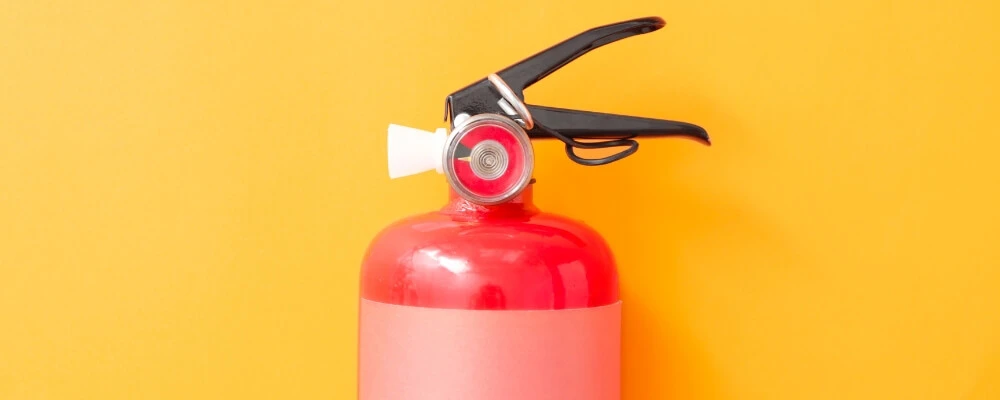
Where to Install Wet Chemical Fire Extinguishers
The installation of Wet Chemical Fire Extinguishers is pivotal in ensuring rapid response during a fire emergency involving cooking oils and fats. Here are the locations where these extinguishers should ideally be installed:
1. Ideal Locations in Commercial Kitchens
Wet chemical fire extinguishers should be strategically located where they can be quickly and easily accessed in the event of a fire. Ideal locations include near cooking appliances prone to grease fires, like deep fryers and grills, but not so close that they are out of reach in a fire. They should be positioned in clear, unobstructed areas, near exits, and away from heat sources.
2. Residential Kitchen Considerations
While primarily designed for commercial kitchens, wet chemical extinguishers can also be useful in residential kitchens, especially in homes with high cooking activity. In this context, place the extinguisher away from cooking appliances but in a location that is easily accessible and visible. Having one near the kitchen exit is advisable so that it can be reached quickly in case of a fire while also maintaining a safe escape route.
3. Placement Guidelines and Regulations
- Visibility and Accessibility: Fire extinguishers should be highly visible and accessible, mounted on a wall, or placed in a stand in an unobstructed location.
- Height Requirements: The carrying handle should be 3-1/2 to 5 feet above the floor for adults and 3 feet for children.
- Signage: Proper signage indicating the extinguisher’s location and type should be displayed prominently.
- Inspection and Maintenance: Regular inspection and maintenance should be performed to ensure the extinguisher is in working order.
- Local Regulations: Comply with local fire codes and regulations regarding the placement and number of fire extinguishers required, which can vary depending on the size and type of the kitchen.
Compliance with the established guidelines and regulations is crucial to ensuring the effectiveness and accessibility of the extinguisher in case of a fire emergency and to avoid any legal complications or penalties.
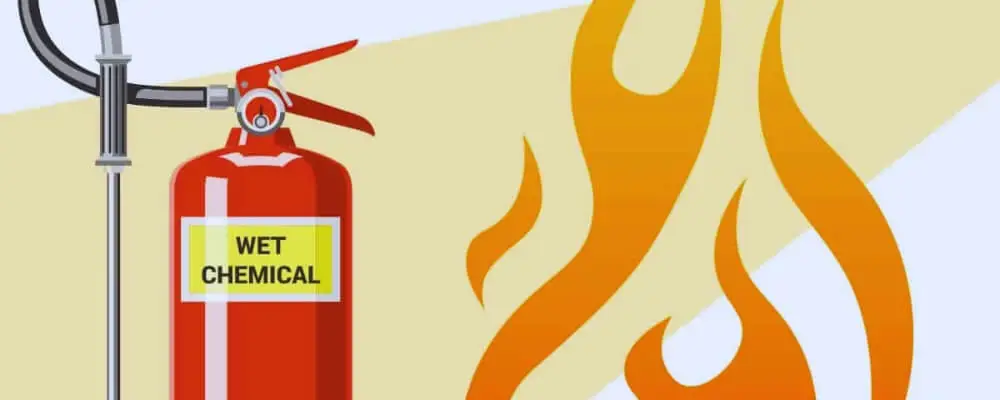
Wet Chemical Fire Extinguishers Maintenance and Inspection
Maintaining and inspecting Wet Chemical Fire Extinguishers regularly is essential to ensure that they function correctly during an emergency. Here are the key points to consider for the maintenance and inspection of these extinguishers:
1. Regular Inspection Schedules
Wet chemical fire extinguishers, like all firefighting equipment, require regular inspections to ensure they are in optimal condition and ready for use in case of an emergency. The NFPA (National Fire Protection Association) recommends a monthly visual inspection and an annual maintenance check by a professional. The monthly checks can be carried out by a designated person within the organization or household, ensuring the extinguisher is undamaged, accessible, and fully charged.
2. Common Signs of Damage or Malfunction
During inspections, the following aspects should be checked to identify any signs of damage or malfunction:
- Pressure Gauge: The needle should be in the green zone, indicating that the extinguisher is properly pressurized.
- Physical Damage: Check for any dents, cracks, corrosion, or other physical damages on the extinguisher body.
- Nozzle and Hose: Inspect for blockages, cracks, or damage that could impair functionality.
- Tamper Seal: Ensure the tamper seal is intact, indicating the unit hasn’t been used.
- Weight: The extinguisher should feel full; if it feels light, it may need recharging.
3. Refilling and Recharging Procedures
Once a wet chemical fire extinguisher is used, even partially, it must be recharged. Qualified professionals should carry out recharging, which involves refilling the extinguishing agent and re-pressurizing the canister. The correct type and amount of extinguishing agent must be used to refill the extinguisher to maintain its efficacy.
Expired or damaged extinguishers should be replaced immediately, and any unit that cannot be adequately repaired should be properly disposed of according to local regulations.
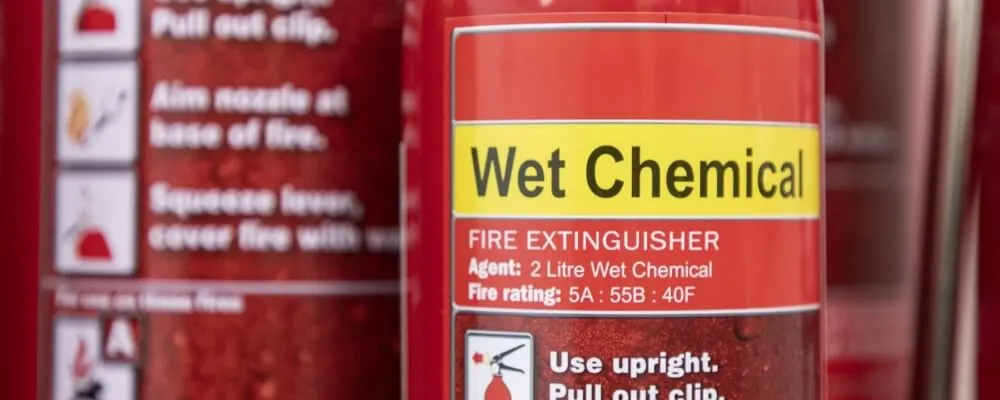
Safety Guidelines when Using Wet Chemical Fire Extinguishers
Adhering to safety guidelines is crucial when using Wet Chemical Fire Extinguishers to ensure the safety of the user and the effectiveness of the extinguishing process. Here are some safety guidelines to follow:
1. Safety Precautions for Users
- Training: Users should be trained on the proper use of wet chemical fire extinguishers to avoid mishandling and accidents.
- Personal Protective Equipment (PPE): Use appropriate PPE, such as gloves and goggles, to protect from chemical splashes or fire-related injuries.
- Read Instructions: Always read the instructions on the extinguisher before attempting to use it, to understand the operational procedure and safety precautions.
2. Safe Distances to Maintain from the Fire
- Initial Distance: Maintain at least 1 meter (3 feet) away from the fire when aiming the extinguisher to avoid contact with the flames or heat.
- Use Long Hose: Utilize the extended hose or lance to apply the chemical from a safe distance.
- Avoid Inhaling Fumes: Stand in a position where the wind is blowing from behind you to avoid inhaling any toxic fumes produced by the fire or the extinguishing agent.
3. When Not to Use a Wet Chemical Extinguisher
- Electrical Equipment: Do not use electrically energized equipment due to the conductive properties of the extinguishing agent.
- Flammable Metal Fires (Class D): Wet chemical extinguishers are not suitable for fires involving combustible metals like magnesium or sodium.
- Unsuitable Fire Classes: Avoid using fire classes that the extinguisher is not designed for, as stated on the label.
- When Fire is too Large: If the fire has spread and is too large, it is unsafe to attempt to extinguish it with a fire extinguisher. Evacuate the premises and call the fire department immediately.
- Inadequate Training: Individuals without proper training or knowledge should not attempt to use fire extinguishers, as improper handling can worsen the situation.
Understanding the safety guidelines, maintaining safe distances from fires, and knowing when not to use wet chemical fire extinguishers are essential aspects of ensuring user safety. These guidelines help in making informed and safe decisions in fire emergency situations, preventing the exacerbation of the fire, and avoiding potential harm to the user and others in the vicinity.
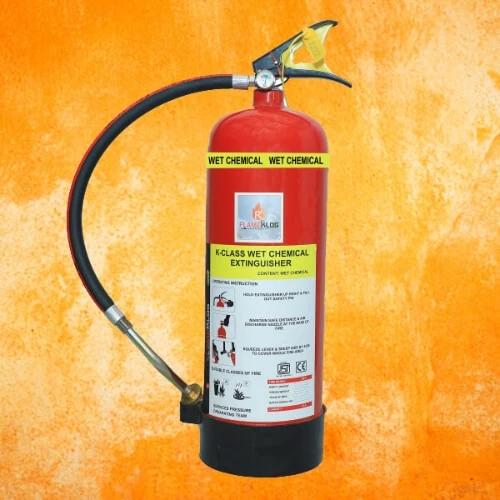
Benefits and Advantages of Wet Chemical Fire Extinguishers
The benefits and advantages of Wet Chemical Fire Extinguishers make them an essential tool for combating specific types of fires. Here are some of the benefits and advantages:
1. Specialized Fire Fighting
- Effective on Class K & F Fires: These extinguishers are uniquely efficient at combating fires involving cooking oils and fats, which are common in kitchen environments.
- Minimized Risk of Re-ignition: The chemical reaction that forms a soapy layer over the fire effectively seals the surface and prevents re-ignition.
2. Safety and Precision
- Extended Applicator: The longer hose or lance allows users to maintain a safer distance from the fire.
- Controlled Discharge: The fine spray enables users to apply the extinguishing agent with precision, avoiding over-spraying and potential splashing of hot oils.
3. Versatility
- Application on Class A Fires: Wet chemical fire extinguishers are also suitable for fires involving solid combustibles like wood, paper, and cloth, increasing their versatility.
- Various Environments: Suitable for both commercial kitchens and, with proper considerations, residential kitchens.
4. User-Friendly
- Clear Instructions: They come with clear, concise instructions for use, allowing for quick and effective application even in stressful situations.
- Ergonomic Design: Features like ergonomic handles and well-designed nozzles make these extinguishers user-friendly.
5. Chemical Efficiency
- Rapid Cooling: The extinguishing agent rapidly cools the burning oil, quickly reducing the temperature and minimizing damage.
- Saponification: The chemical reaction with hot oils and fats produces a non-combustible, soapy foam, which acts as a barrier between the fuel and the fire.
6. Regulatory Compliance
- Meeting Standards: Having wet chemical extinguishers in commercial kitchens helps in complying with fire safety regulations and standards.
- Reduced Liability: Proper compliance with fire safety regulations can lead to reduced liability in the event of a fire.
7. Accessibility and Visibility
- Distinct Labeling: The yellow label and red body make it easily identifiable and distinguishable from other types of fire extinguishers.
- Various Sizes: Available in different sizes to cater to different needs and space availability.
The benefits and advantages of wet chemical fire extinguishers underscore their significance in enhancing fire safety in environments where cooking oils and fats are prevalent. Their specialized design, versatility, user-friendly features, and compliance with regulatory standards make them a crucial tool in mitigating the risks associated with kitchen fires.
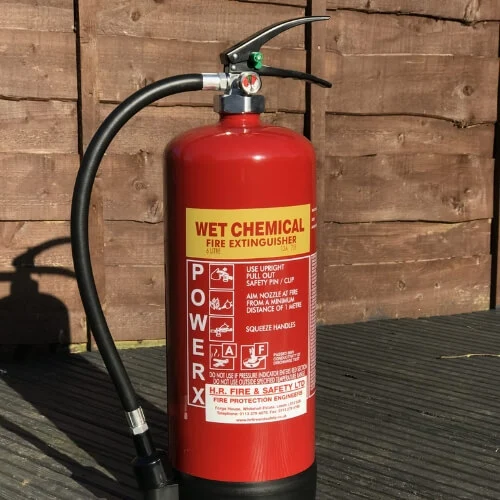
Limitations and Considerations of Wet Chemical Fire Extinguishers
While Wet Chemical Fire Extinguishers are indispensable for certain types of fires, it is important to be aware of their limitations and considerations. Here are some points to consider:
1. Limited Applicability
- Specific Use: Wet chemical extinguishers are primarily designed for Class K and F fires, limiting their applicability in environments where other types of fires are more likely.
- Not Suitable for Electrical Fires: Due to the conductive nature of the extinguishing agent, they shouldn’t be used on fires involving energized electrical equipment.
2. Specialized Training Needed
- Usage Complexity: These extinguishers may require users to undergo special training to use them properly and safely, particularly in commercial settings.
- Operating Procedures: The users need to understand the correct application technique to avoid any injury and ensure effective firefighting.
3. Potential Toxicity
- Toxic Fumes Production: Post-extinguishing, the area should be well-ventilated due to the potential formation of toxic fumes.
- Residue Clean-Up: The clean-up post-use can be extensive due to the soapy residue left by the extinguishing agent.
4. Size and Portability
- Bulkiness: Some models might be bulkier due to the need for a larger amount of extinguishing agent, impacting portability.
- Space Consideration: The installation location needs to be carefully considered, especially in residential settings, due to the size of the extinguisher.
5. Maintenance and Inspection
- Regular Maintenance: These extinguishers require regular inspections and maintenance to ensure they are in working order.
- Refilling and Recharging: After each use, they need to be properly refilled and recharged, which could incur additional costs.
6. Cost Implications
- Initial Investment: The initial cost of purchasing a wet chemical fire extinguisher can be higher compared to other types of extinguishers.
- Maintenance Costs: The recurring costs associated with inspections, maintenance, and refilling can also be a consideration for some users.
While wet chemical fire extinguishers are indispensable for addressing specific fire risks, especially in kitchen settings, it is essential to consider their limitations and specific use cases. Understanding these considerations is crucial to making informed decisions regarding fire safety equipment and ensuring the safety and well-being of individuals in both residential and commercial environments.
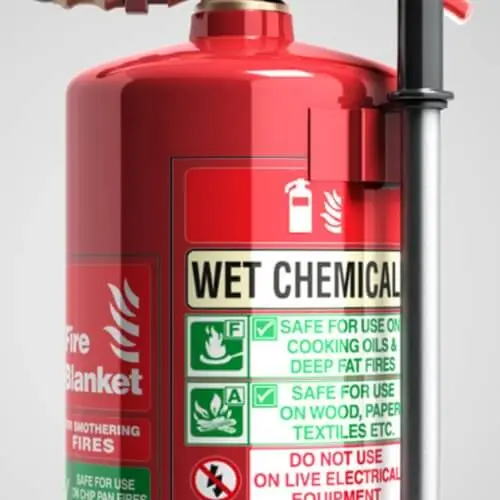
Regulations and Compliance
Complying with regulations and standards is crucial in ensuring the safety and effectiveness of wet chemical fire extinguishers. Here are some of the key regulations and compliance requirements:
1. NFPA (National Fire Protection Association) Standards
NFPA establishes a set of standards that are internationally recognized, providing guidelines for the installation, maintenance, and use of wet chemical fire extinguishers.
For wet chemical extinguishers, NFPA 10 is particularly relevant as it specifies the standards for portable fire extinguishers. It provides important information on the correct type, placement, and maintenance of extinguishers.
2. Local Fire Codes and Regulations
Local fire codes are generally derived from international and national standards but might include additional requirements depending on local considerations and experiences. Compliance with local fire codes is mandatory for both commercial and residential buildings.
These local regulations can specify the number and type of extinguishers required, their placement, and the need for regular inspection and maintenance.
3. Compliance Requirements for Commercial Establishments
Commercial establishments, especially those with kitchens such as restaurants and hotels, must strictly adhere to fire safety regulations. These regulations are in place to ensure the safety of both the staff and the customers. Commercial kitchens are required to have Class K fire extinguishers (Wet Chemical Extinguishers) installed due to the high risk of fires involving cooking oils and fats.
These establishments must also ensure that the extinguishers are easily accessible, in working order, and that staff are trained on their use. Non-compliance can result in fines and business closures and can also impact insurance policies.
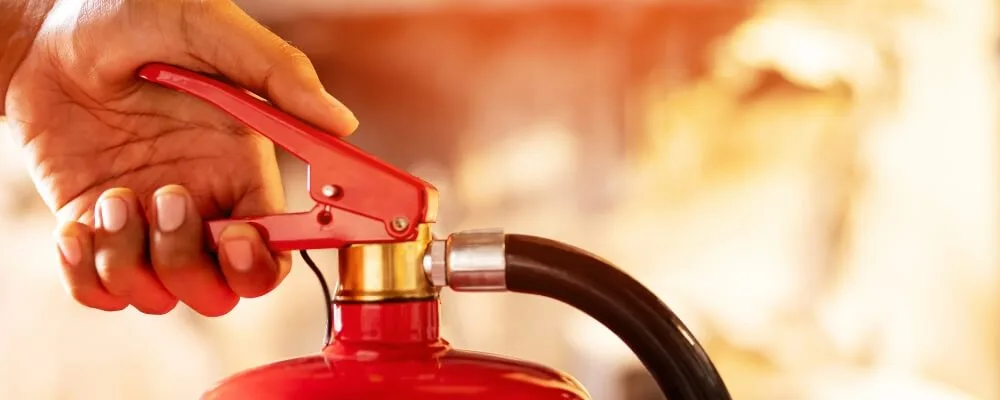
Training and Education for Using Wet Chemical Fire Extinguishers
Training and education are crucial components in ensuring the safe and effective use of wet chemical fire extinguishers. Proper training ensures that individuals can respond efficiently during a fire emergency, reducing the risk of injury and property damage. Here are the key aspects of training and education for using wet chemical fire extinguishers:
1. Importance of Training
Training and education are pivotal for ensuring the proper use and handling of wet chemical fire extinguishers. The correct knowledge and understanding of operating procedures can be the difference between containing a fire successfully and experiencing a catastrophic event. Training enables individuals to act confidently and efficiently in the event of a fire, minimizing damage and injury.
2. Training Components
- Theoretical Understanding: Individuals should have a sound understanding of the different types of fires and the appropriate fire extinguisher to use for each.
- Practical Application: Hands-on training allows individuals to become familiar with the extinguisher’s operation, ensuring they can act quickly during an actual fire emergency.
- Safety Precautions: Training should cover the necessary safety precautions and the correct distance to maintain when operating the extinguisher.
- Maintenance Knowledge: Knowledge about inspection schedules, common signs of damage, and refilling procedures are crucial for maintaining the extinguisher in a state of readiness.
3. Educational Resources
- Workshops and Seminars: Regular workshops and seminars can provide essential information and practical knowledge about the use and maintenance of wet chemical fire extinguishers.
- Online Courses and Tutorials: These offer convenient and accessible ways to gain knowledge about fire safety and can be especially useful for ongoing learning.
- Instructional Manuals and Labels: Reading and understanding the manuals and labels on the extinguisher provide crucial information about its operation and limitations.
- In-house Training Sessions: For commercial establishments, conducting regular in-house training sessions ensures that all staff members are well-acquainted with fire safety protocols and the use of extinguishers.
4. Training Providers
- Local Fire Departments: They often offer training sessions and educational resources to the community and businesses, focusing on the proper use and maintenance of fire extinguishers.
- Professional Training Organizations: These organizations specialize in providing comprehensive fire safety training, including practical sessions on using different types of extinguishers.
- Online Learning Platforms: Many online platforms offer certified courses on fire safety that cover extensive material on the subject, including the use of wet chemical extinguishers.
5. Certification
Receiving certification upon completion of training programs provides proof of an individual’s capability to handle and operate fire extinguishers effectively. It ensures that the person has undergone a structured learning process and has understood the safety procedures, operation mechanisms, and maintenance protocols associated with wet chemical fire extinguishers.
Conclusion
In conclusion, wet chemical fire extinguishers are an indispensable component in fire safety, especially in environments like commercial kitchens where the risk of Class K fires is prevalent. These extinguishers, specifically designed to combat fires involving cooking oils and fats, operate by employing a concoction of alkali salts, which create a sealing foam to cool and neutralize fires effectively.
The utilization of these extinguishers involves a comprehensive understanding of their features, operation mechanisms, and safety guidelines, which are essential for maximizing their effectiveness and user safety.
Fire safety awareness is pivotal in residential and commercial settings, and regular maintenance, inspection, and adherence to compliance and regulations are paramount in ensuring preparedness and responsiveness in the event of a fire. The importance of training and education cannot be overstated, as they equip individuals with the knowledge and skills necessary to operate fire extinguishers correctly and make informed decisions during fire emergencies.
The balancing act between benefits and limitations, coupled with a comparison with other extinguisher types, provides a broader perspective, enabling informed choices and promoting a safer and more secure environment.

